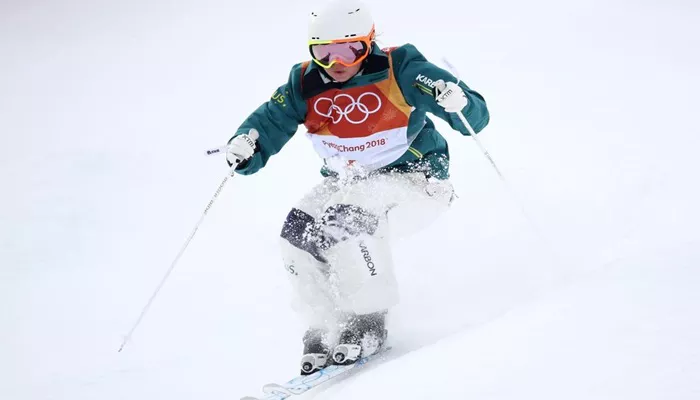Mogul skiing is one of the most exciting and dynamic disciplines in Olympic freestyle skiing. This high-energy event requires athletes to navigate a field of tightly packed snow bumps, known as moguls, while executing technical turns, high-speed maneuvers, and aerial tricks. It is a test of agility, control, and athleticism, making it a thrilling spectacle for both competitors and spectators alike.
In this article, we will explore the origins of mogul skiing, the structure of Olympic mogul courses, judging criteria, techniques used by athletes, and what makes this sport such a unique part of the Winter Olympics.
The Origins of Mogul Skiing
Mogul skiing originated from the natural bumps formed on ski slopes due to repeated turns by skiers. Over time, these bumps became a recognized feature of skiing, and competitive mogul skiing emerged as a distinct discipline.
Mogul skiing was first introduced in the Winter Olympics as a demonstration sport in the 1988 Calgary Games and became an official Olympic event at the 1992 Albertville Games. Since then, it has remained a staple of freestyle skiing, attracting elite athletes from around the world.
Understanding Moguls: What Are They?
Moguls are bumps that naturally form on ski slopes due to repeated skier traffic. In competitive mogul skiing, these bumps are purposefully shaped and spaced to create a challenging course that tests skiers’ technical precision and endurance.
Structure of an Olympic Mogul Course
An Olympic mogul course is a meticulously designed ski slope featuring:
Length: Typically between 200 to 270 meters (656 to 886 feet).
Width: Around 18 to 20 meters (59 to 66 feet).
Mogul Spacing: Moguls are placed approximately 3.5 meters (11.5 feet) apart.
Incline: The slope’s gradient ranges between 26 and 30 degrees, making it a steep and demanding descent.
Jump Sections: Two mandatory jump areas where skiers perform aerial tricks.
Judging Criteria in Olympic Mogul Skiing
Mogul skiing is not just about getting down the slope the fastest; it is a combination of speed, technique, and style. Olympic mogul competitions are judged based on three main criteria:
1. Turns (60% of the Score)
The majority of a skier’s score comes from their ability to execute controlled, fluid, and symmetrical turns through the mogul field. Judges assess:
Body positioning and stability.
Consistency in turn size and rhythm.
Edge control and absorption of the bumps.
2. Aerial Maneuvers (20% of the Score)
Skiers must perform two aerial tricks during their run. These jumps are evaluated based on:
Difficulty and execution of tricks (such as flips, spins, and grabs).
Landing stability and control.
Amplitude (height) of the jump.
3. Speed (20% of the Score)
While control is crucial, speed also plays a significant role. The fastest skiers earn higher scores, but excessive speed at the cost of technique can result in deductions.
Techniques Used in Olympic Mogul Skiing
Mogul skiing demands a unique set of techniques that allow athletes to maintain control, minimize impact, and maximize efficiency. Below are the key skills required:
1. Absorption and Extension
Mogul skiers use their legs to absorb the impact of each bump and extend them on the downward slope. This technique helps maintain balance and prevents excessive bouncing.
2. Upper Body Stability
The upper body remains relatively still while the legs do the majority of the work. Athletes keep their arms close to their bodies and use their ski poles for additional balance and rhythm.
3. Aggressive Line Selection
Choosing an efficient path down the mogul course is critical. The fastest skiers take a direct line while maintaining control, rather than weaving excessively between bumps.
4. Perfect Timing in Jumps
Aerial tricks are a vital part of the event, and timing is everything. Skiers must launch off the jump with enough speed and precision to complete their tricks while ensuring a stable landing.
The Evolution of Mogul Skiing in the Olympics
Over the years, mogul skiing has evolved in terms of difficulty and athleticism. Modern skiers incorporate increasingly complex aerial maneuvers, such as corked spins and backflips, into their runs.
Advances in ski technology and training methods have also allowed athletes to achieve greater speeds while maintaining technical precision.
Famous Olympic Mogul Skiers
Several athletes have left a lasting impact on the sport. Some of the most notable Olympic mogul skiers include:
Jean-Luc Brassard (Canada) – Gold medalist at the 1994 Lillehammer Olympics.
Hannah Kearney (USA) – Gold medalist at the 2010 Vancouver Olympics.
Mikaël Kingsbury (Canada) – The most decorated mogul skier, winning gold in 2018 and silver in 2014.
Perrine Laffont (France) – 2018 Olympic champion and dominant force in women’s moguls.
Conclusion
Mogul skiing is a thrilling Olympic event that combines technical precision, high-speed skiing, and aerial acrobatics.
Athletes must master a combination of balance, control, and strategy to navigate the demanding course while impressing judges with their skill and speed.
Whether you are a seasoned skier or a fan of the Winter Olympics, understanding the intricacies of mogul skiing enhances appreciation for the incredible athleticism and dedication required in this exhilarating sport. As the event continues to evolve, new generations of athletes push the limits, making Olympic mogul skiing one of the most exciting spectacles in freestyle skiing.

